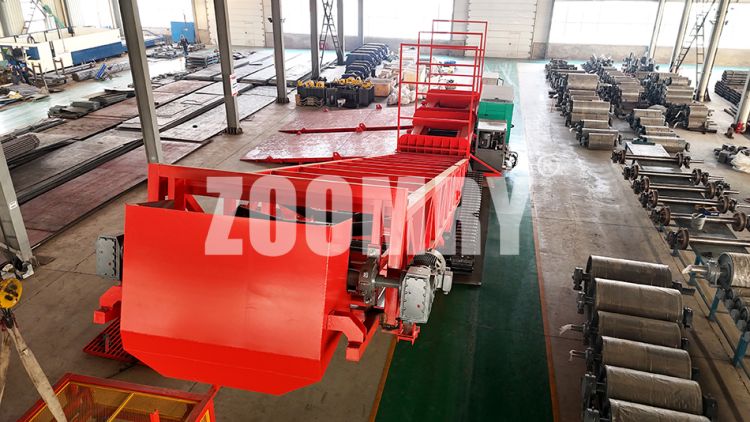In heavy industrial settings such as mining and ports, truck unloaders must withstand extreme temperature fluctuations ranging from -60°C to +65°C. According to a 2024 report by the International Materials Handling Association (IMHA), global losses due to bulk material equipment failures in extreme climates exceed $3.8 billion annually, with hydraulic system failures accounting for 58%. As a truck unloader manufacturer certified with CE, EAC, and eight other international standards, Zoomry Heavy Industry has pioneered a comprehensive temperature control system that successfully overcomes dual challenges of extreme cold and heat.

Ultra-Low Temperature Operation Technologies
Advanced Cryogenic Materials and Thermal Management
Zoomry's ultra-low-temperature steel and titanium alloy composite structure maintains 45J impact energy at -40°C, demonstrating 170% higher crack resistance than conventional materials. This system integrates PTC ceramic and microwave dual-mode heating devices, achieving rapid heating at 8°C/min. Paired with NLGI 0-grade temperature-sensitive lubricant maintaining 420±10 penetration at -55°C, it effectively resolves lubrication failures in extreme cold.
Arctic Equipment Activation Protocol
Cold-start procedures activate phase-change energy storage units to preheat power modules, maintaining energy density above 300kJ/kg. The intelligent hydraulic oil compensation system precisely regulates oil temperature to 18±2°C. Progressive load testing gradually increases from 10% to 50% rated capacity while monitoring drive shaft torque fluctuations below 5% safety threshold.
24/7 Monitoring and Alert System
Distributed strain gauge networks continuously collect structural stress data, automatically triggering three-stage alarms when exceeding 235MPa. Bearings feature 0.8°C/min temperature rise monitoring, validated through TÜV Rheinland's 72-hour cryogenic simulation tests with 100Hz data sampling and ±0.5°C accuracy.
High-Temperature Environment Solutions
Composite Heat Dissipation Technology
Gallium-based alloy thermal modules achieve 78W/m·K conductivity, 320% more efficient than copper solutions. Silicon nitride ceramic coatings withstand +800°C with self-healing microcapsules, extending service life beyond 15,000 hours. Dynamic power allocation algorithms reduce energy consumption by 23%.
Precision Temperature Regulation
Dual-redundancy thermal controls maintain hydraulic oil at 72±3°C using infrared imaging and PT100 sensors. Laser interferometers monitor structural expansion below 2.8mm/m, while MEMS humidity arrays ensure electrical cabinet humidity remains under 30%RH.
Thermal Stress Management
Multidimensional thermal databases integrate 17 temperature field models. Proprietary heat flux analysis software predicts localized overheating 2 hours in advance, coordinating 8m/s forced convection cooling. EP630/5 Conveyor Belts with silicon carbide reinforcement reduce friction heat by 42%, lowering surface temperatures 18°C.
Critical High-Temperature Parameters
| Monitoring Parameter | Control Standard | Measurement Method |
|---|---|---|
| Hydraulic Oil Temp | 72±3℃ | IR Imaging + PT100 |
| Structural Expansion | ≤2.8mm/m | Laser Interferometry |
| Electrical Cabinet RH | <30% | MEMS Sensor Array |
Note: Specific configurations require customization based on actual working conditions.
For inquiries about extreme-environment truck unloader operations, contact us via:
- Zoomry Official Website
- +86 131-6401-6717
- oversea@zoomry.cn
Project Case Study
Zoomry's tracked truck unloader in Brazil's Carajás iron ore region withstands 2,800mm annual rainfall and pH 4.2 acidic conditions. The main frame combines wear-resistant steel (550HB hardness) with 316L stainless steel welding, passing ISO 9016 phased-array inspections to ensure stress corrosion resistance. The HPS-7 hydraulic system maintains 35MPa pressure with fluoroelastomer seals (HM4 hydrolysis resistance), reducing leakage to 0.03ml/min.
For 18% moisture content ore, engineers redesigned bucket elevators using CFD simulations. The 22° domed hopper reduces water adhesion by 42%, while 120m³/h drainage pumps activate automatically via radar level sensors when water exceeds 15cm, improving response speed by 87%.
Micro-arc oxidation coatings (50μm thickness) demonstrate 0.002mm/year base material corrosion in 3,000-hour salt spray tests. Tungsten carbide plasma-sprayed chains (<2% porosity) with self-lubricating bearings extend wear cycles from 800 to 1,500 hours. Operational data confirms 820t/h wet ore unloading capacity (26% improvement) with 85.5% reduced electrical failures.
The breakthrough thermal-channel drainage system utilizes hydraulic waste heat, maintaining 35-40°C drainage paths via 38 PT100 sensors. This innovation enables 72-hour continuous operation during torrential rains, setting new benchmarks for tropical rainforest operations.
Why Choose Zoomry
-
Proprietary high-strength alloy achieves 1,200MPa tensile strength with 18% elongation at -60°C, certified by Lloyd's Register to overcome metal embrittlement.
-
Phase-change energy storage units triple thermal density, enabling ±2.5°C hydraulic control across -70°C to +65°C ranges.
-
34-type sensor arrays create digital twins with 1ms data sampling, providing 90-minute failure预警 at 98% accuracy.
-
Modular designs allow 4-hour replacement of hydraulic drives and thermal modules in polar regions.
-
IE5 efficiency variable-frequency drives with regenerative braking cut energy use 23%, saving $180,000 annually in Saudi projects.
-
16 global service centers include Arctic (-50°C response <2hrs) and equatorial stations (7×8 storm support).

 ZOOMRY
ZOOMRY

